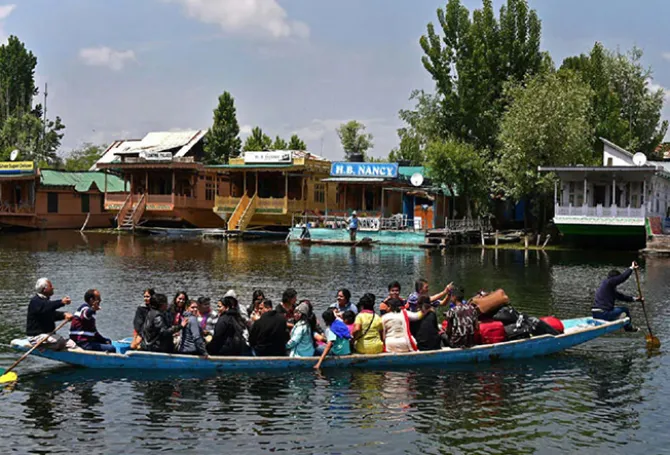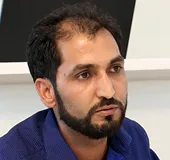
During the first seven months of 2023, the Union Territory (UT) of Jammu and Kashmir welcomed 12.7 million tourists. This figure may go up to 22.5 million by the end of the year, a significant increase from last year's 18.8 million tourist arrivals, which was the highest number of tourists in the UT since India’s independence. Significantly, the number of foreign tourists to the UT has seen a 700-percent increase from 4,028 foreign arrivals in 2022 to 30,647 in the first eight months of 2023.
Tourism in the conflict-torn Valley also psychologically assists the Kashmiris by exposing them to cultures other than Pakistan’s ‘implemented’ gun culture that they have witnessed for decades.
The increase in the number of domestic and foreign tourists to the region is the best indicator of peace returning to the Valley post-August 2019, thanks to increased safety and security. Tourists choose not only their destinations based on price and location but also their personal safety and security. The large influx of tourists is helping the region's economic transformation and is catalysing the move towards positivity and peace. Tourism in the conflict-torn Valley also psychologically assists the Kashmiris by exposing them to cultures other than Pakistan’s ‘implemented’ gun culture that they have witnessed for decades. Increased tourism is catalysing tolerance, a growing acknowledgement of the rights of others and, most significantly, reviving the Valley's traditional syncretic culture.
G20 meeting and revival of tourism
Kashmir, known for its pristine beauty and lush green valleys, was one of the favourite destinations for domestic and foreign tourists from 1960-80. However, in 1989, Pakistan and its agencies started its armed conflict and terrorism in the Valley by infiltrating thousands of terrorists and misleading a section of gullible Kashmiris towards insurgency. Since August 2019, there has been a positive transformation in the security situation in Kashmir Valley. The presence of terrorists has decreased significantly, and incidents of “quasi violence” such as stone pelting and strikes, which Pakistan often instigated have all but ended, especially since 2021. The people of Kashmir, particularly the youth, are on the brink of a significant transformation in their attitude towards Pakistan and its policies of terror in the region. Only 25 young people from Kashmir have joined militancy this year, compared to 143 in 2019 and 100 in 2022. Additionally, out of the 46 terrorists killed in the UT, only nine were locals, with the remaining 37 being Pakistani nationals. This marks the first time in the last 33 years of militancy that the elimination of foreign terrorists has been four times higher than that of locals. However, it is pertinent to mention here that 29 of these terrorists were killed in the south of the Pir Panjal region bordering Pakistan, indicating Islamabad’s frustration and the changing security environment of the Valley.
The increased number of tourists exclusively from Muslim countries has thwarted and exposed Pakistan's false accusations of human rights violations in Kashmir by New Delhi within the Muslim world.
Increased tourist footfalls reveal the changed ground reality, especially the evolving perception of the youth towards New Delhi, both economically and politically. New Delhi also took the opportunity provided by the G20 presidency to showcase the Valley’s abundant tourism potential to the affluent global economies. On 22 May, the Third G20 Tourism Working Group (TWG) convention was held in the Kashmir valley for green, inclusive, and resilient tourism development. The meeting helped the UT administration learn from global best practices for attaining the SDGs and forced many countries to be lenient on their travel advisories. The G20 meeting in Kashmir has helped in the sweeping increase of foreign tourists. Out of 30,647 foreign tourists, most were from Europe, the Middle East, Malaysia and Thailand. The increased number of tourists exclusively from Muslim countries has thwarted and exposed Pakistan's false accusations of human rights violations in Kashmir by New Delhi within the Muslim world. On 04 August 2023, British Arab influencer Amjad Taha visited Kashmir and was inspired by “India’s peace measures” within the Valley.
Government initiatives
Pakistan is currently facing a multitude of political and economic challenges, while Kashmir is emerging as a prime destination for both domestic and international tourists, providing local Kashmiri youth with a range of economic opportunities. The tourism industry contributes to approximately 7-8 percent of the UT's GDP, generating an annual revenue of over INR 80 billion. This revenue helps uplift the local economy and has increased direct or indirect employment in the Valley, especially among youth. Considering the increasing tourist demand and the UN Sustainable Development Goals (SDG), the government also started a homestay project with special assistance for every unit. This year, the number of registered homestays has increased substantially, and the government is committed to increasing the number of rooms by 55,000 through this project. For example, in the districts of Baramulla, Kupwara and Bandipora, there are 250 registered homestays with a capacity of 900 rooms.
Pakistan is currently facing a multitude of political and economic challenges, while Kashmir is emerging as a prime destination for both domestic and international tourists, providing local Kashmiri youth with a range of economic opportunities.
It is time for the UT administration to highlight the tourism potential of Kashmir at a global level, especially in the Middle East, Europe, and the United States (US). The UT administration also promotes 75 new pristine destinations to attract more high-end tourists. However, except Pahalgam, Gulmarg, and Sonamarg, the other destinations need more basic tourism facilities, amenities like mobile connectivity, electricity supply, and public toilets. For example, Gurez Valley, only 125 km away from Srinagar, needs proper infrastructure, especially electricity, public restrooms, and roads. Although the UT has undertaken new policy interventions to create more eco-friendly infrastructure to revive tourism to its fullest potential, the administration must create additional tourism infrastructure. New Delhi also needs to create more economic opportunities and expedite connectivity projects such as expanding railway networks and widening of the strategic 295 km NH44 into a four-lane road. These two strategic connectivity projects are essential for economic growth, especially in the horticultural sector of the region, as well as tourism. Last year, road closures due to landslides and geological instability caused valley-wide protests by fruit growers and merchants, resulting in a loss of over INR 1,500 crores to the apple industry, the backbone of Kashmir's economy. The Kashmir Valley produces about 75 percent of the apple crop in India and contributes about 8.2 percent to the GDP of the Union Territory (UT) of Jammu and Kashmir. Completing these crucial connectivity projects will keep the skyrocketing airfares under check during peak tourist season. These two strategic connectivity projects will transform the tourism and horticulture sectors and will create economic integration and cement ideological integration. Subsequently, security forces and common Kashmiri population must remain more vigilant and tactical against Pakistan's rogue, frustrated agencies and changing terror policy.
Ayjaz Wani is a Fellow in the Strategic Studies Programme at the Observer Research Foundation.
The views expressed above belong to the author(s). ORF research and analyses now available on Telegram! Click here to access our curated content — blogs, longforms and interviews.




 PREV
PREV


